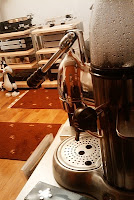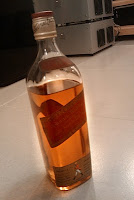 The Yumcha Diaries: 19-09-09大而有當 系则成统Part I: 大而有當--HiFi 精 A--First Encounter with Goto Drivers
The Yumcha Diaries: 19-09-09大而有當 系则成统Part I: 大而有當--HiFi 精 A--First Encounter with Goto DriversLast week, we were glad to see two more surprise guests at yumcha and the pentagon promptly forgot about the terrorists and had a good time bonding. Afterward, three of us went to re-audition the famous setup of Alansoo (aka
HiFi 精 A), which needs little introduction. It's been a while since I last visited, and now much has changed. I forgot to bring my camera, but despite some lapses I still hope my report is richer in details than what pass for hifi reports out there (almost only pics). Briefly, the gigantic setup uses 5 amps (some details may be erroneous; forgive me, given the complexity) :
Horn system:
TAD 2401 + (18"?)
JBL woofer +
1x GOTO (super) tweeter + 2x
Pioneer (super) tweeters.
No electronic crossover is used.
Digital:
ARC CD-7
LP:
EMT 950
Preamp:
Bruce Moore tube preamp driving
(Super) tweeter amps:
Russell (according to Alan precursor of
Final) and something else I am blocking.
Midrange amp: A very nicely made
300B amp using 5U4 rectifier and 6SN7 drivers and
Tamura trannies.
Bass amp:
Parasound(Sub) woofer amp:Professional Class-D amp; forgot name
First, let's not mince words. This is a heck of a system, as you ALWAYS expect from this man. It was so good I almost didn't go upstairs to check out his museum (listening to the top-of-the-line
Kuzma shall have to wait till next time). From a whisper to a full orchestral cry, sound was much more effortless than previously, when Alan didn't use so much power. From Kogan's violin to jazz, everything has the proper scale.

I just got my Shura Cherkassky Liszt Hungarian Fantasia CD (LP heard so effectively at 珠寶梁's place; The LP may be hard to find, but the CD is not freely available either. This performance by the great pianist is buried in a 2-CD Liszt album.
Click for full info).
Yes, this is not the LP, but the piano sound is rich and full-bodied, and appropriately big in size! Wonderful! I urge you to get this one.
My attention was particularly focused on the rare and VERY expensive Goto drivers, of legendary status and the dream of many horn buffs. I do not care whether they are Titanium or Beryllium, and no matter since the sound was very beautiful and smooth and I was not aware of an edge or any grain, rare in my experience with supertweeters. Info is very hard to come by on these drivers; try the following links:
6moons article on GotoGoto USA/check out Flash picsGreat Goto horn systems; Note the metallic tweetrsAlan told me he suspects the $300K
Magico Ultimate II uses a Goto tweeter.
If you know of any good Goto websites, please let me know!
Sound was remarkably coherent given 5 amps were being driven. Each amp has its own volume, and I am sure Alan had spent a hugh amount of time adjusting the knobs! If a slight dryness remains, I shall attribute it to the speakers themselves. If there is any loss compared to previously, when I heard just the 2401 driven fullrange by a single amp (and different components) sound might have been just a tad (not punt intended) more coherent then. But given the enormous gain in dynamics I'd say the gargantuan effort has been worth it.
How many times have you visited million-dollar big setups that are 大而不當? Alan's setup is not THAT expensive, but it sure is
大而有當 and Goto is surely Ichiban!
After that I went to visit yet another smaller but meritorious setup...
 Part II. 系则成统--When Amati meets SMEPhoto of the setup borrowed from here
Part II. 系则成统--When Amati meets SMEPhoto of the setup borrowed from here. Go to link for more pics. Note TT is now different.
After Alansoo I was joined by 2 more friends in a visit to simcity. This was my first visit to his beautiful new home, the interior of which was all designed by himself.
I have known simcity for quite a while. To me, he has a good ear and can instantly tell you what he thinks. One evening long ago, when he and some other friends came to my place, we were switching components and I found myself in agreement with most of his comments, all instant and on the fly. Previously, he had a rather small LR yet the sound was reasonably balanced. The current setup is as follows:
LP:
SME 20/2A with
SME V arm/
Benz Micro Ebony
Phono preamp:
Pass lab XP-15Digital:
Mark Levinson transport into
Orpheus DAC
Preamp:
Conrad Johnson Act2Amp:
CJ Premier 350 ss amp
Speakers:
Sonus Faber Amati
Much of the setup has changed over time, but his loyalty to
Conrad Johnson remains. In fact you can go to his thread in R33 (
打做我的影音天地) to see detailed description of his CJ love story and previous gears.
We warmed up by listening to his digital setup. From the first instance, and unlike some of my previous encounters with Orpheus, sound was warmly musical, with good rhythmic and dynamic integrity and fine tonal balance.
Sonus Faber is a brand I have always admired and I miss the Concertino and Signum that I have sold previously. Luckily I still have a pair of Elector Amator II in NYC, still the best transducer for massed strings that I have heard. The Amati, much like Cremona, is not an easy speaker to get right. This pair of Amati is likely the most balanced higher-model SF floorstanders that I have heard. Its seamless balance and musicality is taken for granted, but what was really surprising was the deep bass, tight and qualitatively right even if the listening diatnce is quite on the short side. simcity told me he went through much trial and error, and that the sound was dreadful at first. If you have trouble with SF, you might want to chat with him, for it sounds great now! The balance was such that we enjoyed all kinds of CDs without encountering even a wink of discomfort.
Althought the SF Amati seemed to be the star of the setup, and much as I admire these speakers, for me the show was stolen by the SME turntable, which we listened to only after one hour.
 In a world of rampant re-packaging, boring sameness, overkill and much ugly acrylics (your esthetics may vary), the understated SME Turntable 20/2A is a breath of fresh air
In a world of rampant re-packaging, boring sameness, overkill and much ugly acrylics (your esthetics may vary), the understated SME Turntable 20/2A is a breath of fresh air and rather uniquely designed by the legendary Alistair Robertson (
click for details in damping and the use of an elaborate set if industrial O-rings as suspension). For me, the no-nonsense industrial look and sensible footprint strike just the right chords. All of this would not matter if the sound were not so fine!
Against a very quiet background, from the first time the stylus touched down on the LP surface, we were served analogue playback of the highest quality. Clean, fine tonal balance and refinement, and excellent PRAT (rhythm and pace). The last is particularly of note, as SME V arm (even the SME TTs) has an undeserving reputation of being rather lacking in life. In my experience, this is true in the case of the Oracle's that I have heard, but I have also heard SME Vs work very well with Michell Orbe, Garrad 301 and, now, SME TT itself. The sound also held fast impressively; no matter how loud we played sound never broke up and there was a sense of supreme confidence. And all this with Benz-Micro, likely not the most dynamic cartridge out there! This is an impressive job.


simcity even took pride in the replay of the trains in Hugh Masekela's famous
Hope album, now on Thorens LP. The myriad details were rendered with utter clarity; the trains were as breathtaking as they could be, lacking in heft only if compared to that rendered by a 15" woofer.
A great turntable! And much thanks to simcity.

 Pics courtesy of oozz. Who's that genie in the bottle? Click to enlarge.
Pics courtesy of oozz. Who's that genie in the bottle? Click to enlarge. After that, we all stopped by sokps' place. He generously let us break the seal on a 20+ year old bottle of Johnny Walker Red, which as you know is emphatically not the same thing as what passes for it now. Popular brands of scotch and brandy are now just ghosts of their former selves. Connoiseur of scotch oozz murmured to himself "tastes like single malt..." That just about said it all (though popular single malt is also not quite their former selves, but the downturn is not as severe). So, the older the better!
After that, we all stopped by sokps' place. He generously let us break the seal on a 20+ year old bottle of Johnny Walker Red, which as you know is emphatically not the same thing as what passes for it now. Popular brands of scotch and brandy are now just ghosts of their former selves. Connoiseur of scotch oozz murmured to himself "tastes like single malt..." That just about said it all (though popular single malt is also not quite their former selves, but the downturn is not as severe). So, the older the better!














